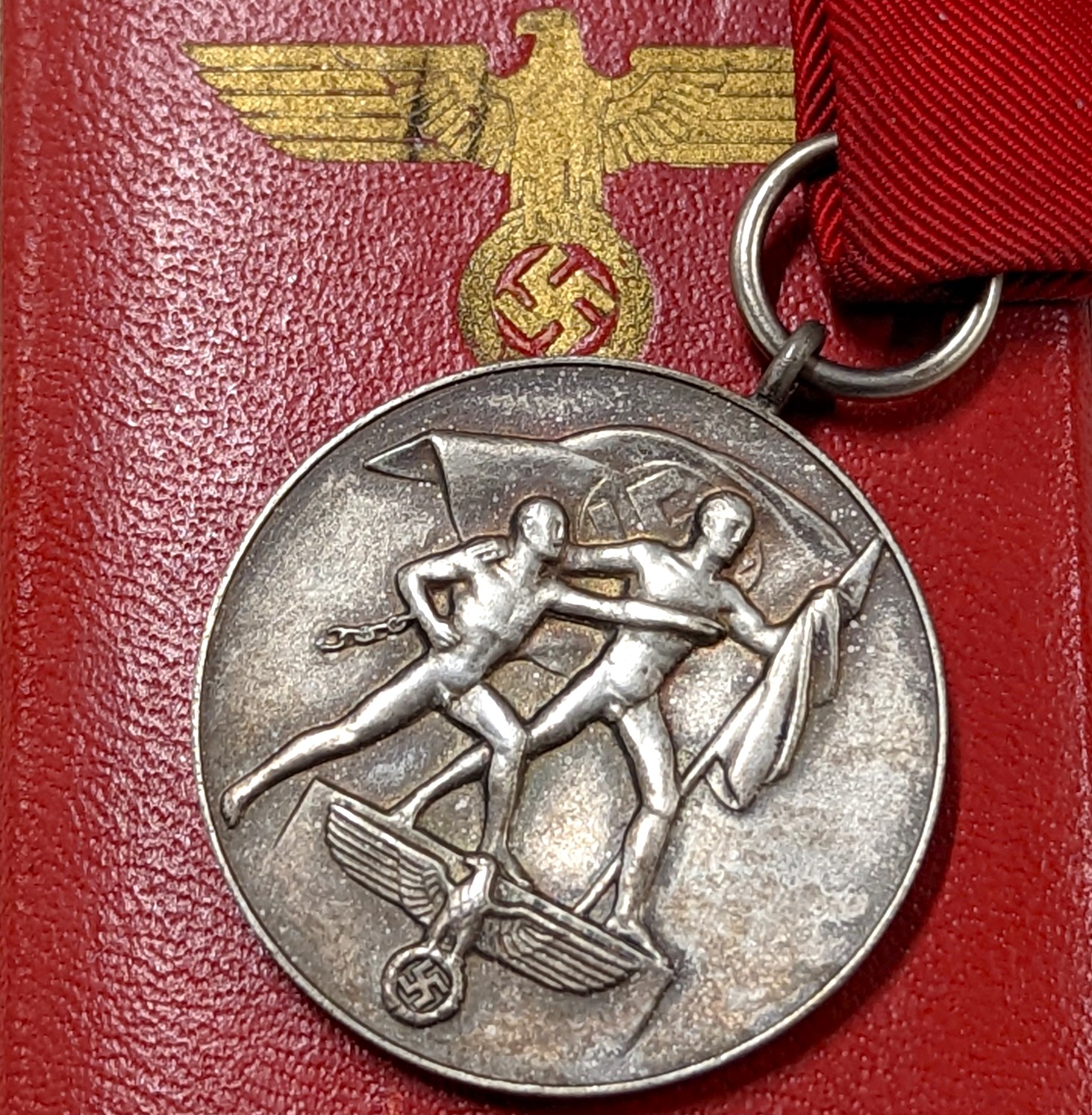SOLD
WW2 CASED GERMAN ANSCHLUSS OF AUSTRIA COMMEMORATIVE MEDAL OF MARCH 13TH 1938
Silver washed, die struck alloy construction medal. The obverse of the medal features two embossed figures symbolically breaking the chains of bondage with an unfurled national flag in the background and a high relief national eagle to the bottom. The reverse features embossed Latin script to the center, “13th März 1938”, encompassed by additional script, “Ein Volk, Ein Reich, Ein Führer”. (One People, One State, One Leader). The ribbon suspension ring and medal loop are both intact and the award comes complete with its original ribbed rayon ribbon with an alloy pin back device, handstitched to the reverse top. Original case is included. The Commemorative Medal of March 13th 1938 was instituted on May 1st 1938 for award to civilians and military personnel who participated in the annexation of Austria into Greater Germany. This was the first of the “Anschluss”, (Union, Annexation), medals, awarded for the “Flower Wars”. Having been born in Austria the union of the two countries was a cornerstone in Hitler’s foreign policy that was expressly forbidden by the Treaty of Versailles. Although the Germans and Austrians had signed an agreement that had guaranteed Austrian independence from Germany, on July 11th 1936, Hitler was determined to absorb […]
$275.00
SOLD
Silver washed, die struck alloy construction medal. The obverse of the medal features two embossed figures symbolically breaking the chains of bondage with an unfurled national flag in the background and a high relief national eagle to the bottom. The reverse features embossed Latin script to the center, "13th März 1938", encompassed by additional script, "Ein Volk, Ein Reich, Ein Führer". (One People, One State, One Leader). The ribbon suspension ring and medal loop are both intact and the award comes complete with its original ribbed rayon ribbon with an alloy pin back device, handstitched to the reverse top. Original case is included.
The Commemorative Medal of March 13th 1938 was instituted on May 1st 1938 for award to civilians and military personnel who participated in the annexation of Austria into Greater Germany. This was the first of the "Anschluss", (Union, Annexation), medals, awarded for the "Flower Wars". Having been born in Austria the union of the two countries was a cornerstone in Hitler’s foreign policy that was expressly forbidden by the Treaty of Versailles. Although the Germans and Austrians had signed an agreement that had guaranteed Austrian independence from Germany, on July 11th 1936, Hitler was determined to absorb Austria into his realm and loyal Nazi’s within Austria did their best to disrupt the Austrian government. On February 12th 1938 Hitler met with the Austrian Chancellor Doctor Kurt von Schuschnigg at Berchtesgaden where Hitler launched into a tirade concerning what he viewed as the Austrian problem and demanded a resolution or threatened that Austria would feel the German’s wrath by an armed invasion. The brow-beat Schuschnigg signed a new agreement with Hitler but intrigued to escape it by holding an Austrian plebiscite for the political union of the two German states, dated March 13th 1938, in the hopes that the Austrian people would vote against the union therefore preserving Austrian independence. At the last minute with threats from Germany, the Austrian plebiscite vote was cancelled, and German troops moved in and occupied Austria. Of Note: After the Germans were established in Austria, a German sponsored plebiscite was held in which the Austrians voted with overwhelming support for the union.
Additional information
| Weight | 0.1 kg |
|---|---|
| Dimensions | 20 × 15 × 8 cm |

